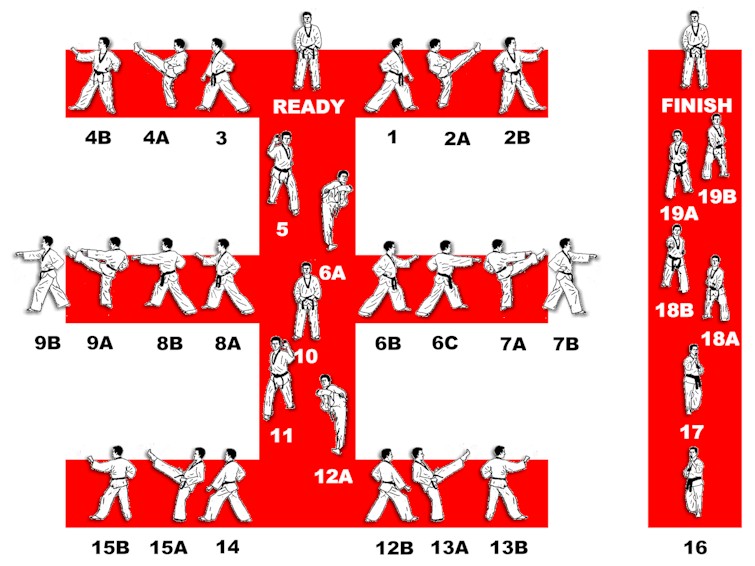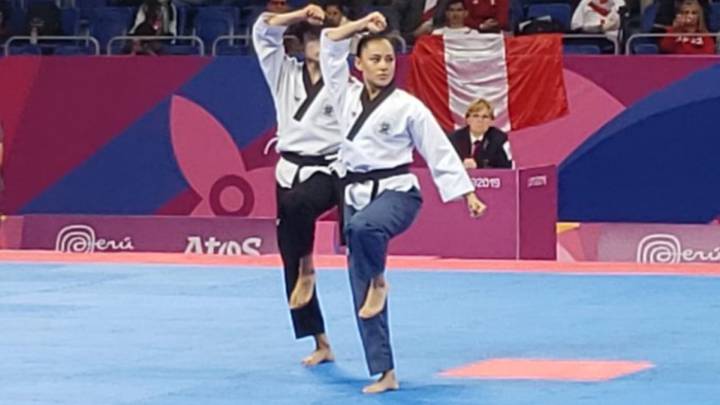The 6th pumse or Poomsae TAEGUK YUK CHANG pushes the student towards the middle of the lines. In this pumse or poomsae the scream or kiap is done in the middle of the exercise and not at the end as in the other poomsaes, specifically in movement 13 and 19.
TAEGUK YUK CHANG is GAM = Water
Poomsae or also known as poomse are different movements that are chained in an already established sequence representing attacks and defenses in a hypothetical situation. Thus each movement and technique has a space within the poomsae. Many martial arts experts link pomsae to karate kata, since they are not the same, they work the same concept and represent the practice of movements in sequence. Poomsae mean «form», a basic way of doing things.
[adsense]
There are two types of poomsae, the Taeguk poomsae and the higher poomsae. The latter have a higher level of complexity unlike the Taeguk poomsae who should be the first to learn the student. Taekwondo has a long and wonderful history but an important point is the appearance of two federations, WTF and ITF. World Taekwondo Federation participated in the collection and recovery of the Taeguk poomsae, these same Taeguk poomsaes come from the palgwe pumses, there are 8 taeguk poomsaes. The word Taeguk means balance.
Taeguk poomsae represent an important technical practice within taekwondo movements, knowledge in poomsaes is also necessary for degree and belt exams as they represent one of the pillars of taekwondo.
Poomsae Taeguk Yuk Chang is the sixth in the line of poomsae taeguk, in fact Yuk refers to number 6. This poomsae represents the GAM principle that refers to the fluid movement of water in most of its scenarios.
Practical scheme of the poomsae
COMPOSITION:
- Sequences: 23
- Movements: 31

What would be the sequence scheme?
Since every poomsae has a set order of movement, it begins with a bow showing respect for martial art and the audience. It is recommended to do stretches and muscle warm-ups to prepare the body, they also help mobility during the execution of the poomsae, since it will look more fluid due to the decrease in muscle tension and increase its flexibility.
- Sequence 1 (Ap kubi sogui- Are maki): this movement is executed to the left of the body, the Are maki, the left arm is aimed at the ground with a fist while the right one is in the form of a semi-flexed hook resting on the side of the ribs. The face looks to the left front.
- Sequence 2 (Ap chagui): a kick is made with the right foot while the left foot does a semi-flex. After doing the kick, the right foot returns and positions both feet in Tuit kubi and runs the Montong baka mari.
- Sequence 3 (Ap kubi sogui – Are maki): the gaze and direction of the body are changed towards the practitioner’s right side, then Are Maki is executed, but on the opposite side to the execution of the first sequence.
- Sequence 4: This movement begins with the execution of the Ap chagui kick, executed with the left foot towards the practitioner’s right side, after executing the kick, the practitioner positions himself in Tuit kubi to perform the Montong bakat maki movement with the Left fist diagonally towards the ceiling while the right arm is around the belt.
- Sequence 5 (Ap Kubi sogui – Bituro jansonnal olgul bakat maki): the right arm is placed in front of the body, with the palm of the hand extended while the right fist is next to the belt with the knuckles facing up. The right leg is forward and is semi-flexed.
- Sequence 6: from the previous position Ap kubi sogui, a Dollyo chagui kick is executed with the left foot while the right foot is maintained as support.
- Sequence 7 (Ap Kubi sogui- Olgul bakat maki): this movement is performed on the practitioner’s left side with the left fist diagonally pointing towards the ceiling while the right fist rests next to the belt with the knuckles up. To finish, Montong baro jirugui is executed.
- Sequence 8: an ap chagui kick is made directing towards the practitioner’s left side and then making an arm movement, the Montong baro jirugui.
- Sequence 9 (Ap Kubi sogui – Olgul bakat maki): it does the same movements as sequence seven including the ending in Montong baro jirugui, the only difference is that it runs on the opposite side, it is done on the right.
- Sequence 10: an ap chagui kick is made towards the right side, then it is positioned in Ap kubi sogui and the Montong baro jirugui is performed towards the competitor’s left side.
- Sequence 11 (Naranji sogui – Gechio are maki): the feet are formed to do Naranji sogui while in the upper body, the two arms are at the height of the belt, semi-flexed, with the fists closed.
- Sequence 12 (Ap kubi sogui – Bituro jansonnal olgul bakat maki): the same movement is performed as in sequence 5, in the same way. Left, an energetic KIAP is made.
- Sequence 13: a Dollyo chagui kick is performed, the kick is made with the left leg, an energetic KIAP is performed.
- Sequence 14 (Ap kubi sogui – Are maki): the same movement as sequence 3 is made, except that it is directed to the practitioner’s left side.
- Sequence 15: An Ap chagai kick is made to the left side. After performing the kick, he positions his feet on Tuit kubi to make the Montong bakat maki move to the left side.
- Sequence 16 (Ap kubi sogui – Are maki): the same movement is performed as in sequence 1, except that it is directed to the practitioner’s right.
- Sequence 17: An ap chagai kick is made to the competitor’s right side. After making the kick, he positions his feet on Tuit kubi to make the Montong bakat maki move to the right side. Same execution as sequence 15.
- Sequences 18-19 (Tuit kubi- Sonnal maontong maki): in this sequence the same movement is made but both on the left and the right side, first the Sonnal maontong maki is made on the left side and then closed with the same position but from right side.
- Sequences 20-21 (Ap kubi sogui – Batagson montong maki): it is positioned with the left leg forward and moderately flexed, the left arm is in front of the body, the palm of the hand is in its side and open while the right fist is around the belt with the knuckles up. Then the kubi sogui position is maintained and a Montong baro jirugui is executed.
- Sequence 22-23: start with a position of Ap kubi sogui and the Batagson montong maki technique is executed, in the same way than in the first phase of the 20-21 in the opposite side, the left side. The same position of Ap kubi sogui continues and it ends with a Montong baro jirugui with the left fist towards the front.
[adsense]

The Taeguk Poomsaes
- TAEGUK IL CHANG: Light and sky. Greatness
- TAEGUK I CHANG: Joy and serenity.
- TAEGUK SAM CHANG: Fire and sun.
- TAEGUK SAH CHANG: Thunder. Courage
- TAEGUK OH CHANG: Represents Wind. Flexibility.
- TAEGUK YOUK CHANG: Represents Water. Fluency
- TAEGUK CHILK CHANG: Represents Summit and mountain. Balance
- TAEGUK PAL CHANG: Represents Origin of life. Yin and Earth. .
[adsense]
👉🏼👉🏼 Share this 💚💚🙏🏻🙏🏻:
